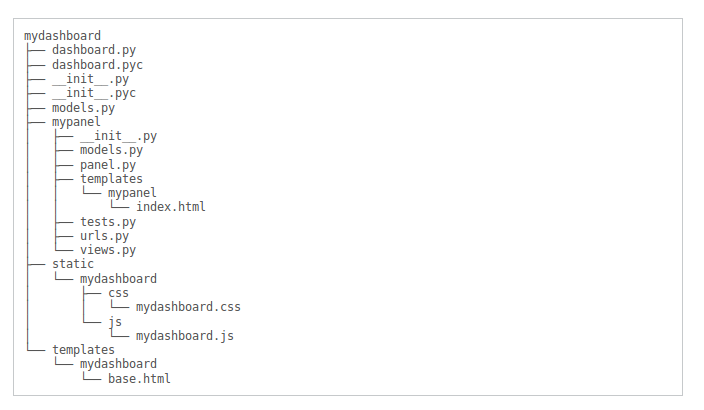How to Creating a dashboard in Openstack
Creating a dashboard
mkdir openstack_dashboard/dashboards/mydashboard
./run_tests.sh -m startdash mydashboard \
--target openstack_dashboard/dashboards/mydashboard
mkdir openstack_dashboard/dashboards/mydashboard/mypanel
./run_tests.sh -m startpanel mypanel \
--dashboard=openstack_dashboard.dashboards.mydashboard \
--target=openstack_dashboard/dashboards/mydashboard/mypanel
Defining a dashboard
Open the dashboard.py file. The following code has been automatically generated:
from django.utils.translation import ugettext_lazy as _
import horizon
class Mydashboard(horizon.Dashboard):
name = _("Mydashboard")
slug = "mydashboard"
panels = () # Add your panels here.
default_panel = '' # Specify the slug of the dashboard's default panel.
horizon.register(Mydashboard)
Creating a panel
Open the panel.py file, you will have the following auto-generated code:
from django.utils.translation import ugettext_lazy as _
import horizon
from openstack_dashboard.dashboards.mydashboard import dashboard
class Mypanel(horizon.Panel):
name = _("Mypanel")
slug = "mypanel"
dashboard.Mydashboard.register(Mypanel)
The completed dashoboard.py file should look like
the following:from django.utils.translation import ugettext_lazy as _
import horizon
class Mygroup(horizon.PanelGroup):
slug = "mygroup"
name = _("My Group")
panels = ('mypanel',)
class Mydashboard(horizon.Dashboard):
name = _("My Dashboard")
slug = "mydashboard"
panels = (Mygroup,) # Add your panels here.
default_panel = 'mypanel' # Specify the slug of the default panel.
horizon.register(Mydashboard)
Tables, Tabs, and Views
Create a tables.py file under the mypanel directory and add the following code:
from django.utils.translation import ugettext_lazy as _
from horizon import tables
class InstancesTable(tables.DataTable):
name = tables.Column("name", verbose_name=_("Name"))
status = tables.Column("status", verbose_name=_("Status"))
zone = tables.Column('availability_zone',
verbose_name=_("Availability Zone"))
image_name = tables.Column('image_name', verbose_name=_("Image Name"))
class Meta:
name = "instances"
verbose_name = _("Instances")
Create a tabs.py file under the mypanel directory.
from django.utils.translation import ugettext_lazy as _
from horizon import exceptions
from horizon import tabs
from openstack_dashboard import api
from openstack_dashboard.dashboards.mydashboard.mypanel import tables
class InstanceTab(tabs.TableTab):
name = _("Instances Tab")
slug = "instances_tab"
table_classes = (tables.InstancesTable,)
template_name = ("horizon/common/_detail_table.html")
preload = False
def has_more_data(self, table):
return self._has_more
def get_instances_data(self):
try:
marker = self.request.GET.get(
tables.InstancesTable._meta.pagination_param, None)
instances, self._has_more = api.nova.server_list(
self.request,
search_opts={'marker': marker, 'paginate': True})
return instances
except Exception:
self._has_more = False
error_message = _('Unable to get instances')
exceptions.handle(self.request, error_message)
return instances[]
class MypanelTabs(tabs.TabGroup):
slug = "mypanel_tabs"
tabs = (InstanceTab,)
sticky = True
Tying it together in a view
the completed views.py file now looks like
the following:
from horizon import tabs
from openstack_dashboard.dashboards.mydashboard.mypanel \
import tabs as mydashboard_tabs
class IndexView(tabs.TabbedTableView):
tab_group_class = mydashboard_tabs.MypanelTabs
template_name = 'mydashboard/mypanel/index.html'
def get_data(self, request, context, *args, **kwargs):
# Add data to the context here...
return context
URLs
The completed urls.py file should look like the following:
from django.conf.urls import patterns # noqa
from django.conf.urls import url # noqa
from openstack_dashboard.dashboards.mydashboard.mypanel import views
urlpatterns = patterns('',
url(r'^$', views.IndexView.as_view(), name='index'),
url(r'^\?tab=mypanel_tabs_tab$',
views.IndexView.as_view(), name='mypanel_tabs'),
)
The template
Open the index.html file in the mydashboard/mypanel/templates/mypanel
directory
{% extends 'mydashboard/base.html' %}
{% load i18n %}
{% block title %}{% trans "My Panel" %}{% endblock %}
{% block page_header %}
{% include "horizon/common/_page_header.html" with title=_("My Panel") %}
{% endblock page_header %}
{% block mydashboard_main %}
<div class="row">
<div class="col-sm-12">
{{ tab_group.render }}
</div>
</div>
{% endblock %}
Enable and show the dashboard
In order to make My Dashboard show up along with the existing dashboards like Project or Admin on Horizon, you need to create a file called _50_mydashboard.py under openstack_dashboard/enabled and add the following:# The name of the dashboard to be added to HORIZON['dashboards']. Required.
DASHBOARD = 'mydashboard'
# If set to True, this dashboard will not be added to the settings.
DISABLED = False
# A list of applications to be added to INSTALLED_APPS.
ADD_INSTALLED_APPS = [
'openstack_dashboard.dashboards.mydashboard',
]


Comments
Post a Comment